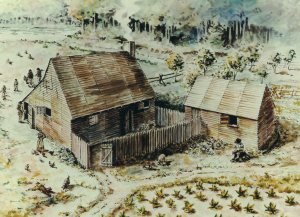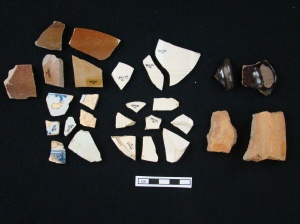Moderator’s note: This week’s blog entry was written by Adam Oster. Adam is a graduating senior at Patuxent High School in Lusby, Maryland. He will be attending the US Naval Academy next semester. He started his internship at the Maryland Archaeological Conservation Lab in March, 2014.
For my internship at Jefferson Patterson Park’s MAC Lab, I was assigned the job of cleaning and labeling artifacts from a site on Bennett’s Point in Queen Anne’s County. The artifacts came from the area in and around the ruins of Bennett’s Chapel, which is the burial place of Richard Bennett III, one of the richest men in colonial history. Many of the artifacts were from later time periods, but the few early 18th-century artifacts which I cleaned included pottery shards, a few of which mated to each other like puzzle pieces. When I was asked to write this blog post, the staff at the MAC Lab suggested that I research the background of Mr. Bennett. So, once I finished labeling all of the artifacts, I began to look at pieces of history.
Richard Bennett was one of the first tycoons ever. His entire life, he purchased acres upon acres of land whenever the opportunity presented itself. By his death, he owned 23,000 acres, one of the only colonial merchant fleets, and the Wye Mill (famous for the Wye Oak, which was only 160 years old at the time). His influence was felt across the entirety of the Maryland Eastern Shore.
Mr. Bennett did not own any land in Calvert County, yet there are interesting connections which tie this millionaire to Calvert

Figure 2: Artist’s conception of the Smith house where Elizabeth Bennett lived. Painting by Tim Scheirer.
County, to the MAC Lab at Jefferson Patterson Park and Museum, and even to a house two miles from my own. Buried next to Richard Bennett is his wife, Elizabeth Rousby (I will try not to make this post a list of genealogies). Elizabeth was the daughter of Barbara Morgan and John Rousby, and her childhood home was located on Rousby Hall Road in southern Calvert County, barely two miles from my own home and my high school, and thus Mr. Bennett is tied to my neighborhood. His connections reach further still. Even when I am driving from school to the MAC Lab, I am driving toward the history of Richard Bennett. When Elizabeth was very young, her father died and her mother remarried to Richard Smith Jr. Elizabeth moved with her mother to Mr. Smith’s residence, located on the land that is now Jefferson Patterson Park and Museum. The Smith house site, now known as “King’s Reach,” was excavated by JPPM archaeologists in the 1980s. Elizabeth was very young when her family moved, so the Smith residence could be where Richard Bennett visited and courted her. As Richard Bennett’s wife, Elizabeth Rousby was influential in her husband’s career. All of the land on Bennett’s Point, including that on which the chapel and the Bennett house resided, was inherited by Elizabeth Rousby from her maternal aunt. The chapel where Richard and Elizabeth are buried can also be credited to Elizabeth and her side of the family; Elizabeth’s aunt asked for the chapel to be built as a part of her last will and testament.
Today, Richard Bennett is mostly forgotten, and his fortune was largely divided at the time of his death. What information I was able to garner about Bennett shares similarities with the artifacts from his chapel. What I learned of him needed to be pieced together from multiple sources, just as the shards were pieced together. What I learned about archeology from my internship is that history must be pieced together just like its artifacts.


